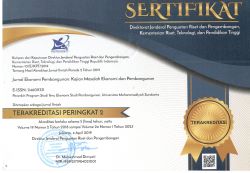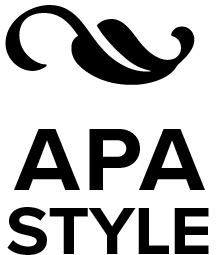TECHNOLOGICAL CHANGE AND ENVIRONMENTAL PROTECTION IN AGRICULTURAL DEVELOPMENT: CAN ECONOMIC AND ECOLOGICAL REASON BE A SYNERGISM?
Joko Mariyono(1*)(1) International and Development Economics, The Australian National University, Canberra-Australia
(*) Corresponding Author
Abstract
Sektor pertanian menjadi salah satu sumber pencemaran terbesar. Penyebabnya ada tiga kemungkinan: perubahan teknologi, model analisis ekonomi yang digunakan, dan kebijakan pemerintah. Hipotesisnya adalah penggunaan model ekonomi yang tidak tepat. Kajian ini mengevaluasi secara teoritis dan empiris model ekonomi, dan mengusulkan sebuah alternatif yang memungkinkan penurunan penggunaan input kimia pertanian. Dengan pendekatan teori produksi mikroekonomi dan ekonometri, kajian ini menunjukkan bahwa model analisis ekonomi yang digunakan selama ini tidak selalu benar dan mungkin menyesatkan. Untuk mendukung model alternatif yang diusulkan, kajian ini menggunakan satu unit data produksi pertanian dan pengenalan teknologi baru.
Hasil kajian ini menunjukkan bahwa bahwa pengenalan teknologi baru tidak serta merta menyebabkan produsen meningkatkan penggunaan input kimia. Perubahan teknologi yang telah menyebabkan pencemaran linkungan pada prinsipnya disebabkan oleh penggunaan model ekonomi yang direstriksi, yang didukung oleh kebijakan pemerintah. Oleh karena itu direkomendasikan untuk meninggalkan model yang direstriksi, dan menggantikannya dengan model yang dimodifikasi dalam mengevaluasi dampak ekonomi dari pengenalan teknologibaru, khususnya di sector pertanian. Terlihat bahwa alasan ekonomi dan ekologis dapat berjalan bersama-sama.Keywords
Full Text:
PDFReferences
Antle, J.M. and S.M. Capalbo. 1988. An Introduction to Recent Developments in Production Theory and Productivity Measurement'. In S.M. Capalbo, and J.M. Antle (eds), Agricultural Productivity: Measurement and Explanation. Resource for the Future, Washington, DC.
Archer, D.W. and J.F. Shogren. 1994. Non Point Pollution, Weed and Risk. J. AgricEcon. 4(1):38-51.
Barbier, E.B. 1989. Cash Crops, Food Crops, and Sustainability: the Case of Indonesia. World Development, 17 (6): 879-895.
Bond, J. W. 1996. How EC and World Bank Policies are Destroying Agriculture and the Environment. Singapore: AgBe Publishing.
Bravo-Ureta, B.E. and A.E. Pinheiro. 1997. Technical, Economic, and Allocative Efficiency in Peasant Farming: Evidence from the Dominican Republic', The Dev. Econ. 35(1): 48-67.
Bumb, B. and C. Baanante. 1996. World Trends in Fertilizer Use and Projections to 2020. International Food Policy Research Institute, 2020 Brief, 38, Washington, D.C.
Cacho, O.T. 1999. Dynamic Models, Externalities and Sustainability in Agriculture, Working Paper Series in Agricultural and Resource Economics 99-4 - April 1999 The University of New England.
Chambers, R. G. 1988. Applied Production Analysis: a Dual Approach. New York: Cambridge Univ. Press.
Coelli, T. J., 1996. Measurement of total Factor Productivity Growth and Biases in Technological Change in Western Australia Agriculture. J. App. Econometrics, 11:77-94.
Conway, G. R. and E.B. Barbier, 1990. After Green Revolution, Sustainable Agriculture for Development. London: Earthscan Pub.
Farrell, M. 1957. The Measurement of Productivity Efficiency. J. Royal Stat. Society, series A 120 (3): 253-290.
Fleischer, G. 1999. The Role of Economic Analysis of Pesticide Use and Policy
Experiences from Country Case Studies, A Publication of the Pesticide Policy Project. Special Issue, 1:208-22.
Freedonia Group. 1995. World Pesticides, Report No. 636 (The Freedonia Group, Cleveland, Ohio.
Grafton, R.Q., W. Adamowicz, D. Dupont, H. Nelson, R.J. Hill and S. Renzetti. 2004. The Economics of the Environment and Natural Resources, Carlton: Blackwell Publishing.
Greene, W.H. 2003. Econometric Analysis. New Jersey: Prentice Hall.
Houndekon, V. and H. de Groote. 1998. Health Costs and Externalities of Pesticides Application in Locust and Grasshopper Control in the Sahel. Paper Prepared for the Annual Conference of the American Agricultural Economics Association, 2-5 Aug. 1998, Utah.
Jansen, W. and N.R. de Londono. 1994. Modernization of Peasant Crop in Columbia: Evidence and Implications. Agric. Econ. 10: 13-25.
Jehle, G. A. and P.J. Reny. 2001. Advanced Microeconomic Theory. Addison-Wesley, Boston.
Jungbluth, F. 1996. Crop Protection Policy in Thailand: Economic and Political Factors Influencing Pesticide Use. A Publication of the Pesticide Policy Project 5.
Kidane, A. and D.G. Abler. 1994. Production Technology in Ethiopian agriculture. Agric. Econ. 10: 179-191.
Kompas, T., T.N. Che and R.Q. Grafton. 2004. Technical Efficiency Effects of Input Controls: Evidence from Australia's Banana Prawn Fishery. App. Econ. 36: 1631-1641.
Kumbhakar, S.C, 1988a. 'On the Estimation of Technical and Allocative Efficiency Using Stochastic Frontier Function: the Case of U.S. Class 1 Railroads', International Economic Review, 29(4): 727-43.
Kumbhakar, S.C, 1988b. 'Estimation of Input-Specific Technical and Allocative Efficiency in Stochastic Frontier Models', Oxford Economic Papers, 40:535-49.
McLaughlin, S. P. 1999. Sustainability Issues in Modern Agriculture. http://ag. arizona.edu/OALS/oals/alrsgp/faculty/ mclaughlin/ issues.html (1 Feb. 1999).
Michl, T.R. 1999. Biased Technical Change and the Aggregate Production Function. Int'l. Rev. of App. Econ. 13(2): 193-206.
Millan, J.A. andN. Aldaz. 1998. Agricultural Productivity of the Spanish Regions: a non-Parametric Malmquist Analysis. App. Econ. 30: 875-884.
Pimentel, D., H. Acquay, M. Biltonen, P. Rice, M. Silva, J. Nelson, V. Lipner, S. Giordano, A. Horowitz and M. D'Amore. 1993. 'Assessment of Environmental and Economic Impacts of Chemical Pesticides Use', in D. Pimentel and H. Lehmann (eds), The Chemical Pesticides Question Environment, Economics and Ethics, New York: Chapman & Hall.
Pincus, J., H. Waibel and F. Jungbluth. 1999. Pesticide Policy: An International Perspective. Pesticide Policy Project Publication Series, 7: 4-22.
Rola, A.C. and P.L. Pingali. 1993. Pesticides, Rice Productivity, and Farmer's Health: an Economic Assessment, IRRI and World Resource Institute, Washington.
Sadoulet, E. and A. de Janvry, 1995. Quantitative Development Policy Analysis, Baltimore: The John Hopkins Univ. Press.
Thiam, A., B.E. Bravo-Ureta and T.E. Rivas. 2001. Technical Efficiency in Developing Country Agriculture: a Meta-Analysis. Agric. Econ. 25:235-243.
Umetsu, C, T. Lekprichakul, and U. Chakravorty. 2003. Efficiency and Technological Change in The Philippine Rice Sector: A Malmquist Total Factor Productivity Analysis. Amer. J. Agric. Econ. 85(4): 943-963.
Untung, K, 1996. Institutional Constraints on IPM Implementation in Indonesia. Publication of the Pesticide Policy Project, Publication Series, 3A: 37-47.
Useem, M., L. Setti and J. Pincus. 1992. The science of Javanese Management: Organizational Alignment in an Indonesian Development Programme. Public Adm. and Dev. 12: 447-471.
Wilkinson, C.F. 1988. Introduction and Overview, in S.R. Baker, and C.F. Wilkinson, (eds), The Effects of Pesticides on Human Health. Princeton: Princeton Scientific Publishing Co. Inc. 5-33.
Wooldridge, J.M., 2003. Introductory Econometrics: a Modern Approach, South western College Publishing.
Article Metrics
Abstract view(s): 633 time(s)PDF: 341 time(s)
Refbacks
- There are currently no refbacks.















